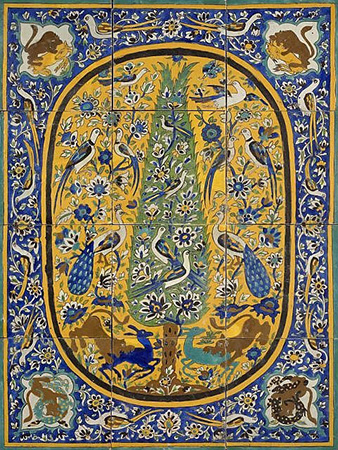Islamic Art Patterns and Their Symbolic Meaning

From the Taj Mahal to the greatest examples of silk Persian rugs, the history of Islamic art spans over a thousand years, crosses borders, and takes on a wide range of genres and forms. Today, the category of Islamic art itself encompasses all types of art that was created in areas where Islam was the main religion. These include the countries of Iran, Egypt, India, Morocco, Spain, Syria, and Turkey, among others. Islamic art does not only refer to religious art; it defines all art forms made in the Islamic world.
Unlike what we often see in Christian or Jewish art, Islamic artists tend to abide by the concept of aniconism; that is, the belief that the creation of living beings, like humans, is a job for God and should therefore be left out of artwork. Islamic aniconism is partly influenced by the prohibition of idolatry, or the worshiping of an idol or image in place of God.
In lieu of human or animal figures in traditional Islamic art (apart from secular Islamic art), we therefore find common Islamic art patterns, designs and motifs. Intricate and colorful works of Islamic ceramics, Islamic wall art and Islamic canvas art often depict repeated examples of calligraphy, geometric and abstract shapes, and representations of flora or vegetation.

While it’s impossible to adequately cover the entire scope of Islamic art — which dates back to the 7th century — in a single article, we’ll explore some of the most important Islamic art characteristics, their influences, and provide a general overview of specific pieces that are sought after by collectors and their value in the market today.
Islamic Art Characteristics
Across Islamic visual art, three key characteristics include floral motifs, geometric designs and calligraphy. Often overlapping across various art forms and genres, these elements are influenced by principles in the Qu’ran.
Floral Designs and the “Arabesque”
Because of the belief in Islamic aniconism, flower designs were used by artists in the place of human or animal forms as Islamic art patterns. These floral motifs seen in Islamic ceramics, carpets, tiles and more avoid a focus on concepts of realism, like growth or life. Certain types of flowers or plants can have theological meanings; the cypress, for example, often represents humility before God.

According to the Museum of Islamic Art Doha, four- or five-petal flowers are typically shown in Timurid manuscripts, Ottomon tiles, Safavid carpets and more. In many types of Islamic artworks like these, we also find what is called arabesque or interlacing, rhythmic, and scrolling floral patterns.
Arabesque surface decoration became widely popular on objects and buildings, and other plant-based designs continued to form complex, scrolling patterns. The V&A Museum notes that techniques for mastering floral patterns and motifs in Islamic art included the use of “grids, reflective and rotational symmetry, and freehand design.”
Islamic Calligraphy Art
Of all the Islamic art characteristics that linked to the Qur’an, calligraphy was perhaps the most direct. Islamic calligraphy art–found on ceramics, metalwork, and across the walls of important structures–quotes verses from the Qur’an, or Allah’s (God’s) word. Scripts of poetry are therefore frequently seen in art and architecture across Islamic world, highlighting the importance of the Arabic language of the Qur’an (but Islamic calligraphy art also encompasses Ottoman and Persian languages). Again, without having to commit idolatry, Islamic artists could use calligraphy to both celebrate and remember Allah without depicting him as a living being.

The traditional tool used by Islamic calligraphers is the qalam, a pen made of dried reed or bamboo. Other techniques involve a metallic-tip pen. Often created with an intense color of ink, mediums for calligraphy include paper, tiles, vessels, carpets and stone.
Islamic Geometric Art
Last but certainly not least in importance is the element of geometry in Islamic art. Combinations of squares and circles form the intricate patterns on various mediums (forms of metal, paper, wood, glass and ceramic material) and art forms (pottery, carpets, jewelry, tiles). They are often seen overlapping with, or perhaps forming the framework for, floral motifs and calligraphy.

The use of geometric patterns involving stars and lozenges dates back to the 9th century. In the 13th century, however, 6- and 13-point star patterns emerged. Later, in the 16th century, artists developed increasingly complex patterns featuring 14- and 16-point stars.
Geometric designs were also popular because they followed Islamic aniconism; they limited focus on figural objects and their complexities allowed for spiritual contemplation. At the same time, these ongoing, looping and scrolling shapes reflected God’s infinite creations, and reflected a sense of divine oneness or unity.
Islamic art covers a broad range of forms and mediums, including paintings, wall tapestries, tile work, stained glass and ceramics, carpets, metal structures, wooden decor, and more. Wall paintings and manuscripts dominated the Persianate world; exquisite rugs were made by Berbers, Persians and Armenians (to name a few); grand mosques with quintessential Islamic art characteristics towered over areas of southern Spain, India, Turkey and Iran. As for Islamic ceramic art, Syria was home to the first industrial complex for glass and pottery production in the 8th century. Wars and invasions, new cultures, as well as traditions that emerged throughout Europe, the Middle East and Asia have had a significant impact on the evolution of Islamic art.









